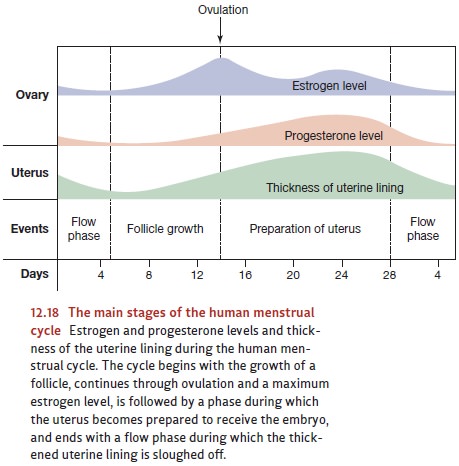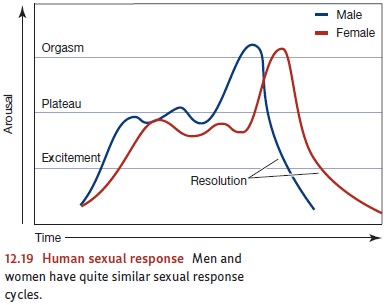Chapter: Psychology: Motivation and Emotion
Physiological Aspects of Sexuality
Physiological Aspects of Sexuality
Sexual
behavior in animals is ultimately about arranging for the union of sperm and ova,
but this can proceed only after male and female have met, courted, and
determined each other to be a suitable mate. At that point, at least for
terrestrial mammals and birds, the male generally introduces his sperm cells
into the genital tract of the female. The sperm then has to encounter a ready
ovum, and finally, the fertilized egg can develop if it is provided with the
appropriate conditions. For now, we note that the sequence of events requires a
complex hormonal control system that links the brain, reproductive organs, and
behavior.
HORMONAL CYCLES
In
sex, timing is everything. Most animals are sexually receptive, and both
biologically and behaviorally prepared to mate, only at certain points in the
year. In mammals, this period of sexual receptivity is known as estrus, and how often it occurs depends
on the species. Female rats, for example, go through a 15-hour estrus period
every four days. At all other times, they will resolutely reject any male’s
advances. If a male nuzzles a female who is not in estrus or tries to mount,
she will kick and bite him. But during estrus, the female responds quite
differently to the male’s approach. She first retreats in small hops, then
stops to look back and wiggles her ears (McClintock & Adler, 1978).
Eventually, she stands still, her back arched, her tail held to the side—a
willing sexual partner.
The
mechanism that causes this change in the female’s behavior is an interlocking
system of hormonal and neurological controls that involves the pituitary gland,
the hypothalamus, and the ovaries. There are three phases (Figure 12.18).
During the first phase, follicles (ova-containing sacs) in the ovary mature
under the influence of pitu-itary secretions. The follicles produce the sex
hormone estrogen. As the
concentration of estrogen in the bloodstream rises, the hypothalamus responds
by directing the pituitary to change its secretions. In consequence, follicle
growth is accelerated until the follicle ruptures and releases the mature ovum.

Release of the ovum triggers the second phase, during which the animal is in estrus. Estrogen production peaks and stimulates certain structures in the hypothalamus, which make the animal sexually receptive.
The
ruptured follicle secretes another sex hormone, progesterone, which dominates the action of the third phase.
Progesterone secretion leads to a thickening of the uterine lining, the first
step in preparing the uterus to receive the embryo. If the ovum is fertilized,
there are further steps in preparing the uterus. If it is not, the thickened
uterine walls are reabsorbed, and another cycle begins. In humans and some
primates, this thickening of the uterine wall involves too much extra tissue to
be easily reab-sorbed; the thickened uterine lining is therefore sloughed off
as menstrual flow.
HORMONAL CHANGES AND BEHAV IOR
These
hormonal changes affect behavior dramatically. When female rats’ ovaries are
removed, they soon lose all sexual interest and capacity, as do male rats when
castrated. But sexual behavior is quickly restored in the male by appropriate
injections of testos-terone and in the female mainly by estrogen (the female
also needs, and secretes, a small amount of testosterone).
Many
investigators believe that the behavioral effects of these hormones are
medi-ated by receptors in the hypothalamus. This hypothesis has been tested by
injecting tiny quantities of various hormones into different regions of the
hypothalamus. Such studies reveal, for example, that a spayed female cat will
go into estrus when estrogen is implanted (G. W. Harris & Michael, 1964)
and that castrated males will resume sexual behavior after receiving doses of
the appropriate male hormones (J. M. Davidson, 1969; Feder, 1984; McEwen et
al., 1982).
Hormones
affect behavior, but the effect can also work in the opposite direction. What
an animal experiences and what it does can substantially affect it hormonally.
In some animals, the female’s courtship behavior can trigger the release of
testosterone in courting males. Conversely, the male’s behavior also influences
female hormones. In many rodents, the female’s sexual receptivity is triggered
by chemicals contained in the male’s urine. In other cases, copulation itself
produces reproductive readiness for the female. For example, the female rat
secretes some progesterone during the normal cycle but not enough to permit the
implantation of the fertilized ovum in the uterus. The critical dose is
secreted only as a reflex response to sexual stimulation. This leaves the
sexually aroused male rat with two reproductive functions: supplying sperm and
providing the mechanical stimulation necessary for the female’s hormonal
secretion. Should he ejaculate too quickly and thus leave the female inadequately
stimulated, all is lost, for no pregnancy results (Adler, 1979; Rosenzweig,
Leiman, & Breedlove, 1996).
HORMONES AND HUMAN SEXUALITY
Compared
to other animals, humans are less automatic in their sexual activities, more
varied, and more affected by prior experience. This difference is especially
marked when we consider the effects of sex hormones. In rats and cats, sexual
behavior is highly dependent upon hormone levels; castrated males and spayed
females stop copulating a few months after the removal of their gonads. In
humans, on the other hand, sexual activity may persist for years, even decades,
after castration or ovariectomy, provided that the operation was performed
after puberty (Bermant & Davidson, 1974).
The
liberation from hormonal control is especially clear in human females. The
estrus cycle of the female rat or cat makes her receptive during only one
period, but human females can respond sexually at virtually all points of their
menstrual cycle. This does not mean, however, that human sexual desire is
completely independent of hormonal influ-ence. If a man or woman has abnormally
low hormone levels, injections of hormones will generally increase his or her
sex drive (J. M. Davidson, 1986; Rosenzweig et al., 1996), and men, with their higher
levels of testosterone than those of women, tend to have a stronger sexual
drive than women have (Baumeister, Cantanese, & Vohs, 2001).
Hormonal
influences are also evident in the fact that women’s preferences and behav-ior
change as they move through their menstrual cycle. For example, women seem to
prefer more “masculine” faces (with a slightly stronger chin and more prominent
brows) if their preferences are assessed during the fertile phase of their
cycle (Frost, 1994; Johnston, Hagel, Franklin, Fink, & Grammer, 2001;
Penton-Voak & Perrett, 2000). In addition, some evidence suggests that
women’s sexual desire increases during the middle of the cycle, when ovulation
occurs. This effect is not very pronounced, however, and has not been observed in
all studies, and thus it seems to be only the vestige of an estrus cycle, left
behind by waves of evolutionary change (Adams, Gold, & Burt, 1978;
Bancroft, 1986; Hamburg, Moos, & Yalom, 1968; Spitz, Gold, & Adams,
1975).
THE HUMAN SEXUAL RESPONSE CYCLE
Our understanding
of the human sexual
response cycle has
its foundation in the
study of hundreds of men and women as they masturbated or had sexual
intercourse in the laboratory (Masters & Johnson, 1966). Findings from
these studies showed that people differed in many aspects of their sexual
responses, but that four general stages seem to characterize both men’s and
women’s sexual responses (Figure 12.19).

The first phase is the excitement phase. In this phase, heart rate and blood pressure increase, breathing quickens, and there is increased muscle tension and blood flow to the sexual organs. For men, the penis becomes erect; for women, the clitoris becomes swollen and the vagina becomes lubricated. In the second or plateau phase, heart rate, blood pressure, and muscle tension continue to rise, but more slowly, while muscles tighten at the base of the penis for men, and in the vagina for women. The third phase is the orgasm phase. This phase is characterized by heightened arousal and a series of rhythmic muscle contractions that lead to ejaculation of sperm in men, and to vaginal contractions in women that help to guide the sperm up the vagina. This orgasm phase is often experienced as intensely pleasurable. The fourth and final phase is the resolution phase, during which time heart rate and blood pressure drop and muscles relax. For men, there is typically a refractory period during which another orgasm is not possible; the length of this refractory period varies from minutes to hours, and increases with age.
Related Topics